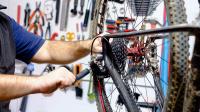Replacing a rim

When you’re about halfway through removing nipples, the assembly becomes sloppy enough on the hub that you can start to transfer spokes to corresponding holes in the new rim. Screw on each nipple about half as many turns as it typically took to remove one. How many turns isn’t critical, so long as it’s the same for every spoke. With the new rim now completely spoked, but loosely, discard the old rim and starting from the valve hole, go once around the rim tightening every nipple one more turn. And repeat, until the spokes are just slightly taut.
Provided you have tightened every nipple exactly the same number of turns, the rim should run pretty true at this finger-tight stage, but it won’t be exact, so put it in the bike and make adjustments until it is true. (You’ll need to completely slacken off the brakes, or even remove the blocks.) First pull down any rim high spots by tightening a few spokes from both sides in that area, each side the same number of whole turns. Then correct any wobbles toward one side by tighten a few spokes from the opposite side of the hub, by quarter turns.
When the rim is true to within 1mm, measure sideways how far it is from, for example, the right brake arm. Take out the wheel and put it back the wrong way round. Measure again. If it’s further away, go around the wheel (from the valve hole) tightening just the spokes on this same side by a half or quarter turn. Or if it’s closer tighten the other side’s spokes. Repeat until you’ve halved that original error and make a note of how far the rim is now from the right brake arm etc. Take out the wheel and put it back the correct way round. The rim should now be in the same place (and if it isn’t, you know what to do).
Make any small necessary adjustments to get the rim within ½mm of true sideways and then also as good as that up and down. Don’t strive for perfection. It’s better have a bit of hop than extreme differences in spoke tension (e.g. from trying to straighten a slightly squiffy rim joint).
Now put on the tension, initially one turn on each spoke, starting and ending at the valve hole. Repeat, going round the wheel one way then the other, until the sound made by the spokes is like you heard before. Then give them all half a turn for good measure. If you want to be precise and have a musical ear, consult John Allen’s web page on Spoke Tension by Ear – or get a tensiometer. I posess neither, but haven’t broken a spoke in any wheel I’ve built for 25 years.
In most wheels the spokes form groups of four. Grasp a group at its ‘waist’ and squeeze hard (wear a glove if it hurts too much). There should be a bit of pinging and popping as these spokes and others are ‘stress relieved’. Go around the wheel doing each group twice.
The wheel will now be slightly out of true. Just take out the sideways hops by fractions of a turn on relevant spokes – maybe a bit of loosening as well as tightening. Sense and precisely locate those hops with the side of your thumb, rested against a brake arm etc. And if a spoke appears to be twisting with the nipple, turn a bit further then back off to relieve the twist.
Eventually a wheel that’s laterally true to ¼mm, and radially to ½mm, is achievable by a careful and methodical first-time amateur. And that’s quite good enough. But if it all goes horribly wrong you’ll at least have saved some of the wheelbuilder’s time – though he might not admit it!
Chris Juden
This was first published in the April / May 2013 edition of CTC's Cycle magazine.